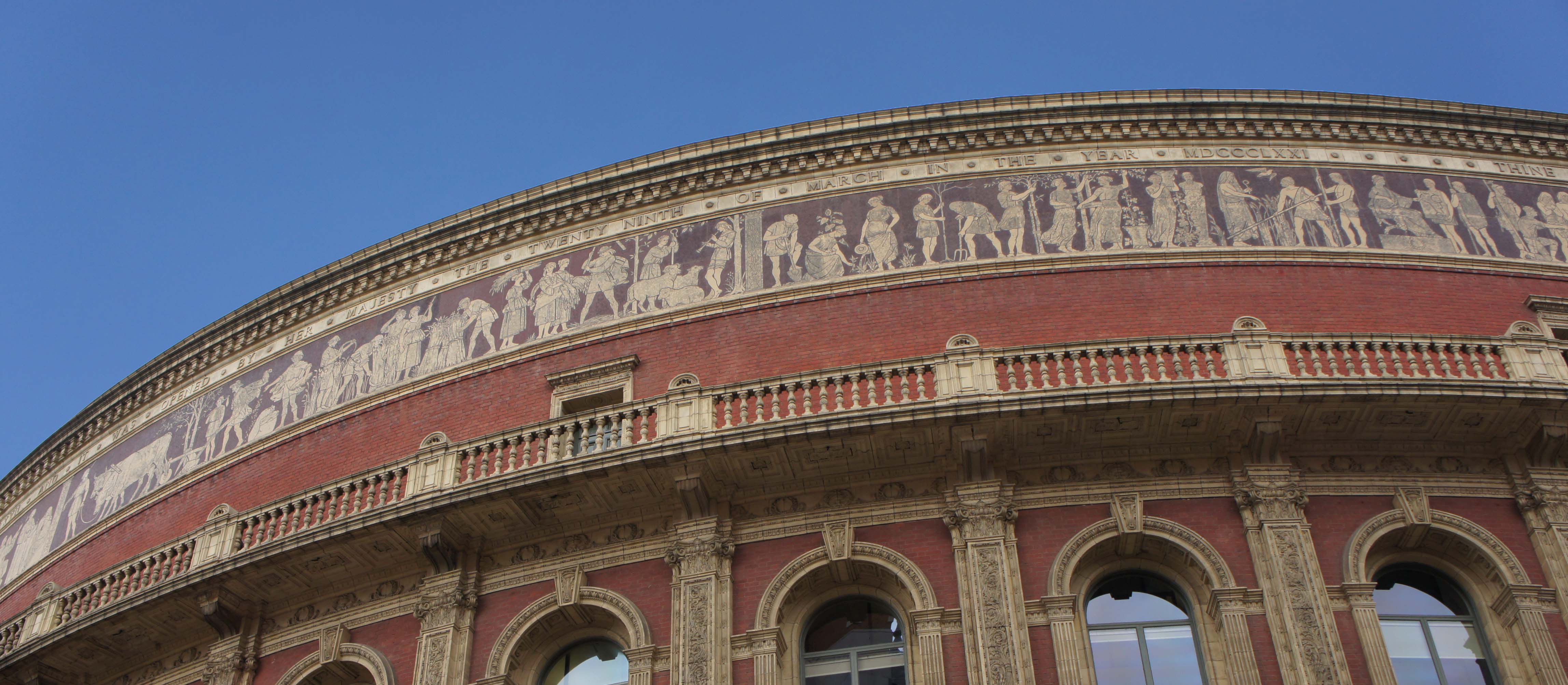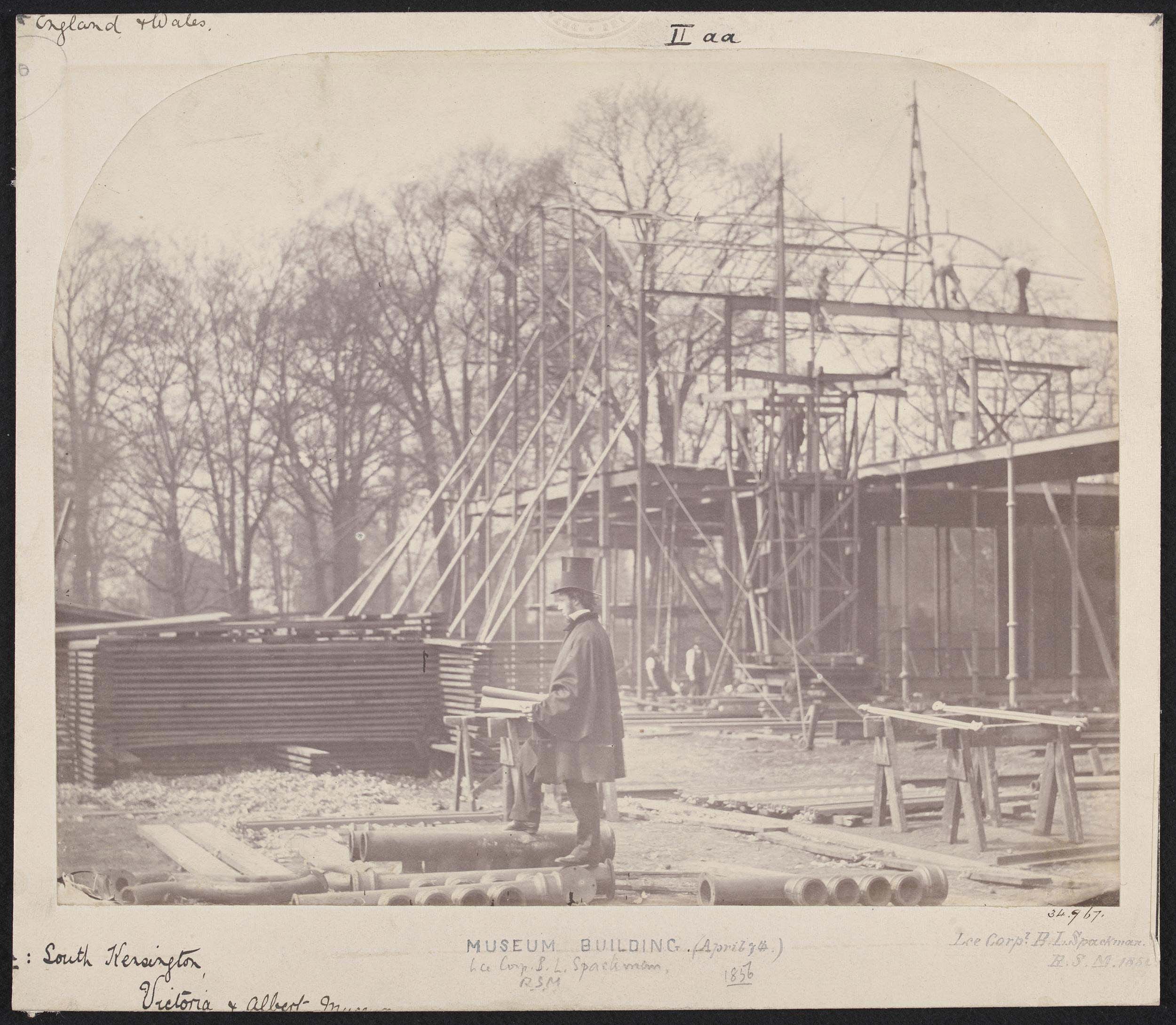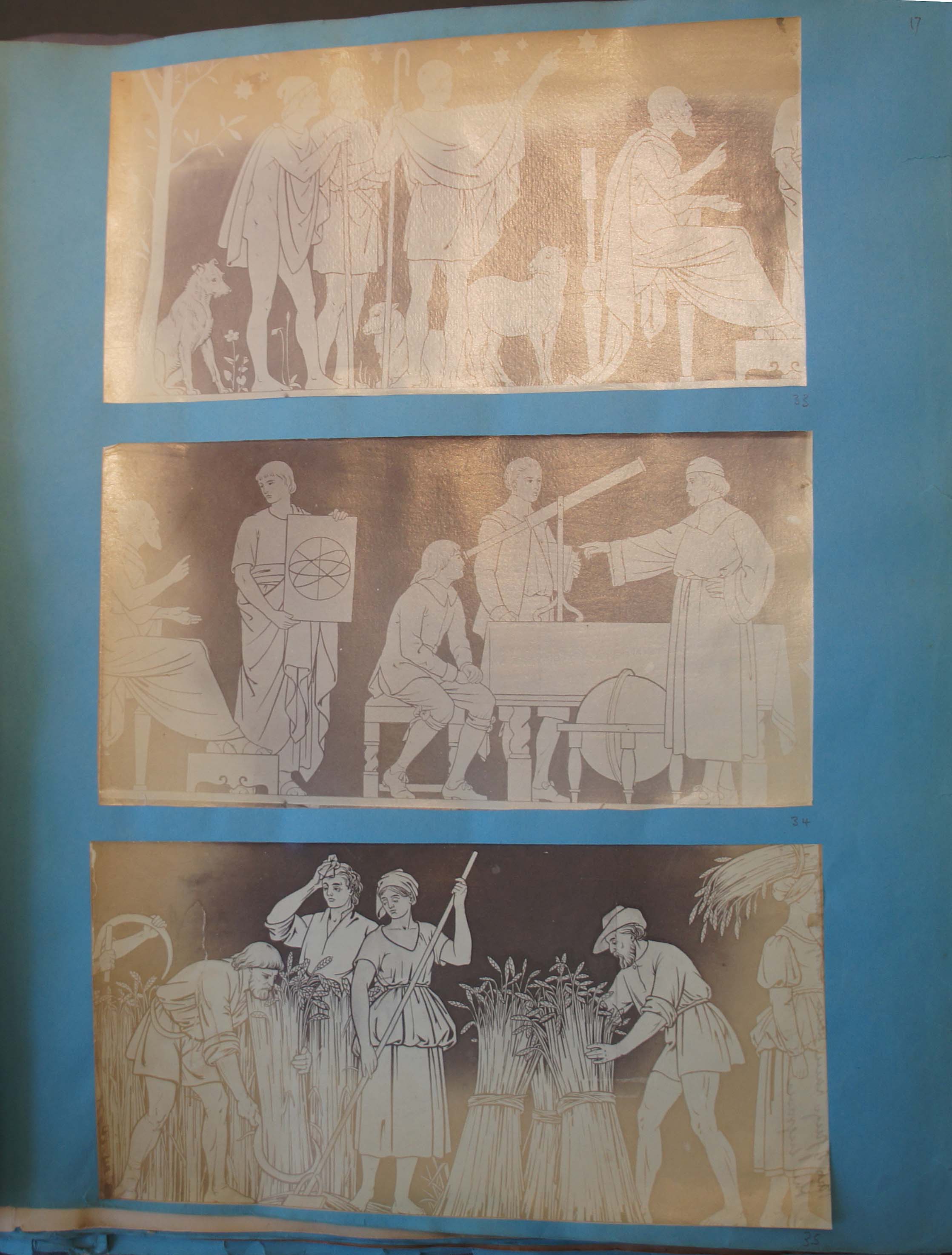This is one of a series of blog posts by students from the V&A/RCA History of Design MA programme to accompany the ‘Building the Royal Albert Hall’ display at the V&A in Room 127 (the entrance to the Architecture Gallery) until 7 January 2018. It is written by Susan Harris.

When visiting the Royal Albert Hall, it is hard not to notice the iconic mosaic frieze [fig.1], which encircles the exterior of the building. What you might not know is the important part played by photographic techniques in the process of creating this frieze. This post will focus on Sergeant Benjamin L. Spackman, the man behind the techniques used, and the role of photography.
Benjamin L. Spackman (born Cheltenham, England, 5 October 1824 – died Dublin, Ireland 5 September 1879) was a sergeant in the Royal Engineers. He was part of the Royal Engineers sappers, who were involved in the construction and documentation of the Crystal Palace and the 1851 Great Exhibition. This led to a group of the Royal Engineers being posted to act as firemen for the new South Kensington Museum (now the Victoria and Albert Museum). Spackman, who was part of this group, benefitted from this arrangement between the military and the Museum, as there were courses set up in 1856 to keep them from inaction and one of the courses was photography, which Spackman showed talent in.[1] He began by producing waxed-paper negatives of the construction of the museum [fig.1] and may have become a principal photographic assistant for Thurston Thompson, the official photographer for the Museum.[2] In 1862, Spackman exhibited photographs of the Horticultural Society’s gardens and the exhibition building; in the official catalogue he was listed as ‘Spackman, B.L. Kensington Museum.[3] For nearly twenty years, Spackman acted primarily as a photographer for the museum, while still remaining a royal engineer. He also lived along with his wife, two sons and one daughter in the sappers’ barracks behind the north cloister of the museum.[4]

Where do Spackman and the role of photography fit into the creation of the mosaic frieze?
Seven artists were entrusted to create the drawings for the frieze, at 800 feet long the area was divided into sixteen sections at the length of about 50 feet each. Some artists took on 2 to 3 sections [fig.3]:[5]
- J. Poynter produced Various Countries of the World bringing in their Offerings to the Exhibition of 1851.
- R. Pickersgill produced Music; Sculpture; Painting; The Infancy of the Arts and Sciences; and Pottery and Glassmaking.
- Armitage produced Princes, Art Patrons and Artists.
- H. Armstead produced a Group of Philosophers, Sages and Students.
- F. Yeames produced Workers in Stone; Workers in Wood and Brick; Architecture.
- Stacy Marks produced Agriculture; Horticulture and Land Surveying; Astronomy and Navigation.
- C. Horsley produced Engineering.

Enlarging these drawings, which were a foot high, was Spackman’s responsibility. He photographed them and projected the negatives using a magic lantern onto a paper screen. By moving the lantern back and forth in front of a paper screen, Spackman could adjust the projection of the drawings to the ideal size. [fig.4] This photographic technique of the magic lantern was cutting-edge at the time and will be discussed further in a future blog post.

Spackman tested the enlargement of the drawings until achieving the final size of 6 feet 6 inches high. It is noted that this was an increase from the initial size agreed to in 1867.[6] What was the initial size? There are measurements noted on the side of F. R. Pickersgill’s ‘The Infancy of the Arts and Sciences’ that indicates the halfway point in the height was approx. 2 feet, which suggests that the initial size of the frieze was around 4 feet.[7] Once these enlargements were outlined in black, they were then passed on to the next stage to Minton, Hollins and Company, who employed the ladies of the South Kensington Museum’s mosaic class to execute the tiling of the mosaic.
The process used by Spackman highlights the role played by photography as a new tool in the design and production process of archictectural decoration at the time. For the Royal Albert Hall frieze, it had the role of bridging the gap between the original drawings and the laying out of the mosaic tiles.
Bibliography
1862 International Exhibition Official Catalogue, vol. II, no.3160
I.L.N. 18 May 1867, p. 493: models of parts of elevation in V.A.M. Dept. of Architecture and Sculpture, A11–1973.
Hamber, Anthony J. A Higher Branch of the Art: Photographing the Fine Arts in England, 1839–80 (Routledge, London, 1996)
Physick, John. Victoria and Albert Museum: The History of Its Building (V&A Publications, London, 1982)
‘Royal Albert Hall.’ Survey of London: Volume 38, South Kensington Museums Area. Ed. F H W Sheppard (London: London County Council, 1975) pp.177–195. British History Online. Web. 20 Feb 2017. http://www.british-history.ac.uk/survey-london/vol38/pp177-195.
Royal Albert Hall Archives.
Scott, Major-General C. B. ‘On the Construction of the Royal Albert Hall’, Papers Read at the Royal Institute of British Architects, Session 1871-72 (London: Rooms of the Institute, 1872), pp.92–4.
Taylor, Roger & Schaaf, Larry J. Impressed by Light: British Photographs from Paper Negatives, 1840–1860 (Metropolitan Museum of Art, New York, 2007)
V&A Word and Images. Corporal Benjamin. L. Spackman scrapbook of photographs, 1860s (Prints & Drawings Study Room, room 512M, case PX4, shelf 1).
[1] Roger Taylor & Larry J. Schaaf Impressed by Light: British Photographs from Paper Negatives, 1840-1860 (Metropolitan Museum of Art, New York, 2007) p.374
[2] Anthony J. Hamber, “A Higher Branch of the Art”: Photographing the Fine Arts in England, 1839–1880, (Gordon and Breach Arts International (2001) p.418
[3] 1862 International Exhibition Official Catalogue, vol. II, no.3160
[4] John Physick, Victoria and Albert Museum: The History of Its Building (V&A Publications, 1982) p.103
[5] Scott, Major-General C. B. ‘On the Construction of the Royal Albert Hall’, Papers Read at the Royal Institute of British Architects, Session 1871-72 (London: Rooms of the Institute, 1872), pp.92–4.
[6] I.L.N. 18 May 1867, p. 493: models of parts of elevation in V.A.M. Dept. of Architecture and Sculpture, A11–1973.
[7] Royal Albert Hall Archives.



Thanks for sharing, it is useful
Really amazing post just original Content.
Indeed you shared really Precious Information.